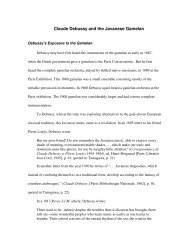Music Preference 1 - Brent Hugh's personal and business web pages
Music Preference 1 - Brent Hugh's personal and business web pages
Music Preference 1 - Brent Hugh's personal and business web pages
You also want an ePaper? Increase the reach of your titles
YUMPU automatically turns print PDFs into web optimized ePapers that Google loves.
<strong>Music</strong> <strong>Preference</strong> 35<br />
applied to each repertoire selection once. The three treatments were applied to the three<br />
repertoire selections as shown in Table 3.<br />
When the data from these experiments were analyzed, data from the repertoire selections<br />
that received treatment N from all three subgroups were grouped together. The data from<br />
treatment N can be compared with similar data from repertoire selections that have received<br />
treatments ID <strong>and</strong> IP. This way of gathering <strong>and</strong> analyzing data has the advantage of canceling<br />
out any differences among the subgroups, because data for each particular treatment come in<br />
equal parts from each of the three subgroups. The experimental method equalizes differences in<br />
preferences due to the different repertoire selections (data for each particular treatment have<br />
equal amounts of data from each of the three repertoire selections) <strong>and</strong> differences due to order<br />
of presentation (each treatment has equal amounts of data from subgroups where that treatment<br />
was presented first, second, <strong>and</strong> third; see Table 4).<br />
In the latin-square design, the subgroups are ideally of equal size. Because of naturally<br />
varying class sizes in the public schools <strong>and</strong> audience sizes at concerts, the subgroup sizes were<br />
initially unequal. For the analyses presented hereafter, all subgroups of a particular group have<br />
been made equal in size by r<strong>and</strong>omly deleting members of larger subgroups.<br />
For groups LE, UE, <strong>and</strong> MS, three repertoire selections were presented <strong>and</strong> three treatments<br />
(N, ID, <strong>and</strong> IP) were tested (see Table 3). For groups HS <strong>and</strong> RA, more time was available for<br />
the presentations. Four repertoire selections were presented with two different treatments (N <strong>and</strong><br />
ID). This effectively doubles the latin square <strong>and</strong> allows twice the data to be gathered from each<br />
group (see Table 5 <strong>and</strong> Table 6). Preliminary studies had shown that music preference ratings<br />
have a high variance <strong>and</strong> that the effect of informational introductions on music preference is<br />
moderate or small. Therefore it was known that a large amount of data would be required to





